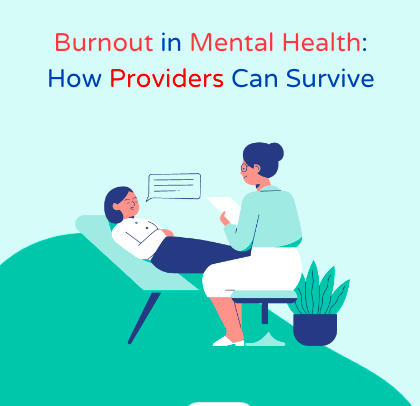The topic of burnout in the field of mental health is often the elephant in the room among providers, but as the demand on therapists increases, it is getting more difficult to ignore.
A 2021 comprehensive study by SimplePractice indicates that 85 percent of responding providers surveyed would choose a different career if they had to start over. The rate of professional burnout is on the rise, with 20 percent of those surveyed feeling this way “always or often” compared to 16 percent in December 2019.
Mental health providers have a fine-line to walk, as burnout impacts their emotional health and work-life balance, but also can impact clients if not addressed.
Therapists who struggle with burnout run the risk of compassion fatigue, offering compromised services, and becoming complacent. While there are no clear answers as to how to solve this multi-level problem, providers can (and should) identify ways to stay well, self-advocate, and find balance.
Identifying Problem Areas and Seeking Solutions
People who offer mental health counseling often guide clients to determine the underlying sources of distress and discontentment. Counselors who start to notice symptoms of professional fatigue can use the same skills to assess problem areas.
By identifying the most challenging aspects of the work, one can determine the types of changes that would help alleviate symptoms. Some questions providers can ask themselves as they are assessing problem areas at work are:
- How is the work impacting you emotionally, physically, and spiritually?
- Which aspects of the work are causing the most dread?
- What are some external supports you need to help reduce symptoms of burnout?
- Are there organizational interventions that could help? (If one is working for an employer)
- What sorts of thought-shifts are needed to support my wellness?
- What would help me cope with emotions about work?
- What are some behaviors I can engage in to support myself?
Mental health providers are sometimes reluctant to share feelings of burnout for fear of professional judgment by peers. Providers experiencing burnout may also worry about sharing these feelings with an employer, out of fear that the employer will assume incompetence.
Silence is the worst approach a provider can take when it comes to experiences with burnout, since it perpetuates the feelings of isolation and fatigue.
Reduce Isolation and Talk About Burnout
Talking about burnout feels risky, but it is the best way to begin addressing the problem head-on. Burnout is a common experience in the field of mental health, and providers who are struggling with it should remember that it is nothing to feel shameful about.
You may find that mentioning your feelings of burnout with peers opens a dialogue that is supportive and compassionate. It is highly likely that your co-workers have had similar symptoms, and this can spark conversations about self-care, professional needs, and advocacy within individual companies and at the state and federal level.
Most importantly, talking about your feelings of professional burnout can relieve the burden of carrying it alone. One of the most common pieces of advice mental health providers offer is to reach out for supports, and this is great advice for providers who are experiencing fatigue and burnout symptoms.
Professional burnout for mental health providers can feel daunting, but sharing your feelings, brainstorming solutions, and shifting one’s workload to accommodate need can reduce the distress.
Strive to create an atmosphere in which your individual needs are being met and shape your practice around your own self-care needs as much as possible.
Try to stay in-tune with the messages of your mind and body as you work on addressing feelings of fatigue and burnout, and make sure you use the advice you would offer a client in this sort of situation.
